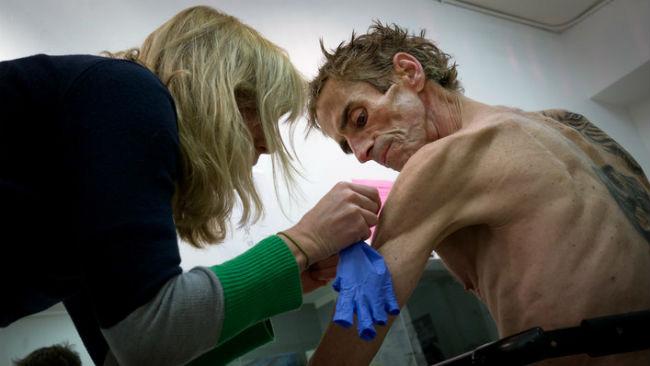Photos: Getting to know the person behind the heroin addiction
A nurse treats Johnny at Vancouver’s Crosstown Clinic before he self-injects his medication.
For more than a year, I’ve been documenting the lives of three long-term drug users — Marie, Cheryl, and Johnny — who are participating in Vancouver’s heroin-assisted clinical study and program.
In recent years, heroin use in North America has exploded into an “epidemic.” At the same time, policymakers and the public have clashed over how to properly treat this public health scourge. Many heroin users receive methadone and other forms of treatment. However, some of the most vulnerable addicts haven’t responded to medication and detox.
I spent weeks building a rapport and trust with these three individuals, who’ve all been addicted to heroin for years. They’ve each tried detox and methadone repeatedly and have been unable to stop using heroin.
In a sense, heroin-assisted treatment, a science-based, compassionate approach, is their last resort.
Those involved in the program — often users who haven’t sufficiently responded to other forms of treatment — receive pharmacological heroin in a clinical setting. While these programs have long been recognized as scientifically sound and cost-saving in countries like Switzerland, the Netherlands and Denmark, heroin-assisted treatment is only beginning to be offered in North America.
At first, the three subjects allowed me to take photos of them self-injecting their medication at Providence Health Care’s Crosstown Clinic in Vancouver’s Downtown Eastside. Slowly, over a period of weeks and months, they let me document their lives outside the clinic.
While I hoped to inform the public about heroin-assisted treatment, I also wanted to see if I could create visual counternarratives to challenge the dominant tropes of drug genre photography.
More than anything, I wanted to represent Marie, Cheryl, and Johnny as human beings — and show that their drug use didn’t define who they were, even though that’s how heroin users are usually depicted by documentary and news photographers.
The best way to do this, I realized, was to show them the photographs I’d selected and give them the opportunity to respond. I included their words with each photograph in the series.
‘Dark, seedy, secret worlds’
Before beginning my project, I had explored the work of some of the most influential drug genre photographers and found that most of them have consistently represented heroin users as exotic, primitive, and dangerous to society.
“There is a tendency in drug photography to attempt to make images of dark, seedy, secret worlds,” writes criminologist John Fitzgerald.
This can have the effect of “othering” the subjects — the idea that after looking at these kinds of images, viewers might look at drug users as outcasts.
Larry Clark’s 1971 photo work “Tulsa” is considered an exemplar of documentary photography. Many view the series, which depicts teenagers experimenting with drugs, sexuality and guns, as brutally honest and revealing.
Clark’s follow-up photo essay, “Teenage Lust,” published in 1983, also focused on drug users in a voyeuristic, unsettling and erotic way.
The problem with this approach is that it creates sensationalized images, which, in turn, influence the public’s thinking and policymakers' decisions about how to treat drug users.
“For Clark the drug user is a modern primitive,” writes Fitzgerald. “Like the young boys who play with guns and explore their sexuality, Clark’s drug users plumb the depths of rapacious desire, so repressed and unexplored in the modern body. Clark’s lifework is to bring this primitive desire to light in a liberal, artistic adventure.”
Clark wasn’t the only photographer to represent heroin users this way. Documentary photographer Eugene Richards' 1994 book "Cocaine True, Cocaine Blue" focused on cocaine use in three inner-city neighborhoods. The book’s cover features an extreme close-up of a woman clenching a syringe between her teeth.
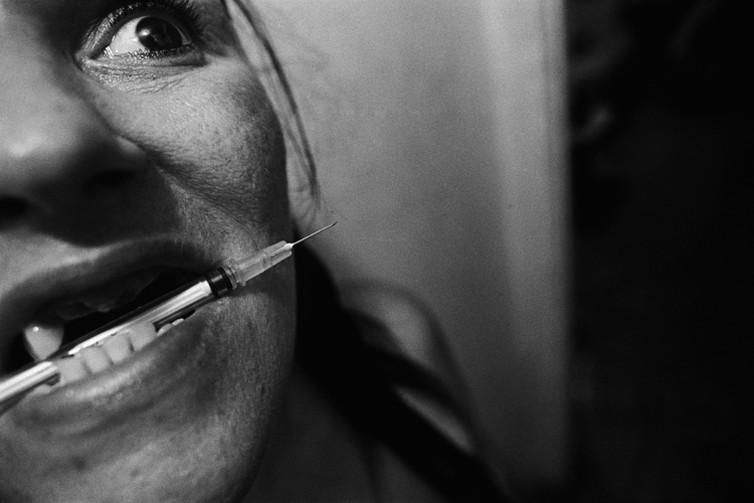
The image is arresting and also influenced the way many other photographers have depicted drug users to this day.
Photojournalists working for news agencies such as AP, Getty Images and The Denver Posthave recently followed Richards' example and captured images of drug users with syringes in their mouths. In most of these photos, the heroin users' eyes are either partially or completely out of frame or hard to make out in detail.
It’s vital that photographers find more balanced ways of representing drug users, instead of reproducing the same types of stigmatizing images that have existed for decades.
Shocking images certainly provoke reactions. But it’s more important to offer context in order to spark discussions about solutions.
Hearing from the heroin users
In my own effort to produce and share balanced and humanizing images — and to reduce the possibility of misinterpretation and “othering” — I realized the images on their own couldn’t tell the full story. I needed a way to provide context for the viewer.
“The multitude of meanings in a photograph makes it risky, arguably even irresponsible, to trust raw images of marginalization, suffering, and addiction to an often judgmental public,” write Philippe Bourgois and Jeffrey Schonberg in their 2009 book "Righteous Dopefiend." “Letting a picture speak its thousand words can result in a thousand deceptions.”
After selecting my final images, I showed them to Marie, Cheryl, and Johnny. I wanted to know if they thought the photos accurately represented them, if they thought anything was missing and what they would have done differently if they had taken the photos themselves.
Many of their responses were positive. They thought that in most of the images, I’d accurately represented them. And they had important suggestions. Most of all, they wanted to be seen in the photos as more than just drug users.
I’ve included their most telling comments alongside each of the photos in this story.
Marie
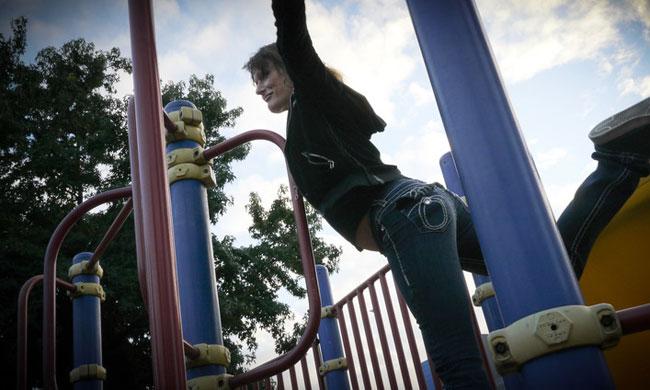
A needle in my arm is only 10 percent of who I am. The other parts are going to the park and playing, having fun outside and watching children play. Being as much a part of as I can be in the community. I’m not just some dirty, mistrusting, drug addict from the skid row.
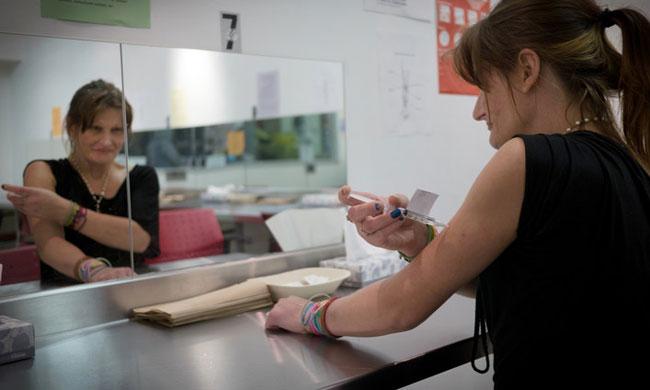
I don’t have to be in alleys [injecting heroin] any more, like I used to be. I’m in a safe environment, no risk of getting or transmitting any infections, and my health is taken care of.
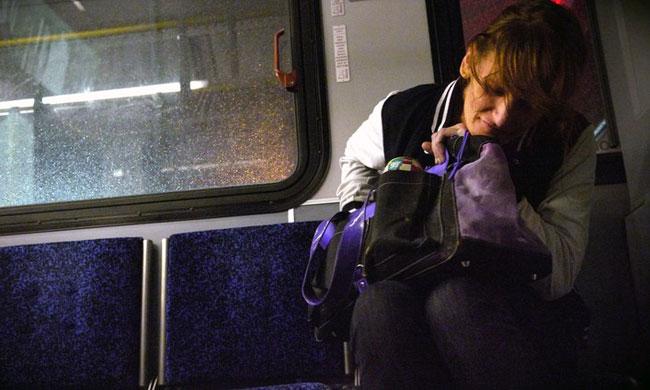
I’m caring for my pet whom I’ve taken on the bus … I’m not selfish … I don’t just think of me and my addiction. That was me, on the bus, going to see my mom. I was going overnight, so I had to take my cat with me. There’s more to my life than addiction … Like my cat. Like my family. Like taking time out to remember where and who I truly am. And where I come from.
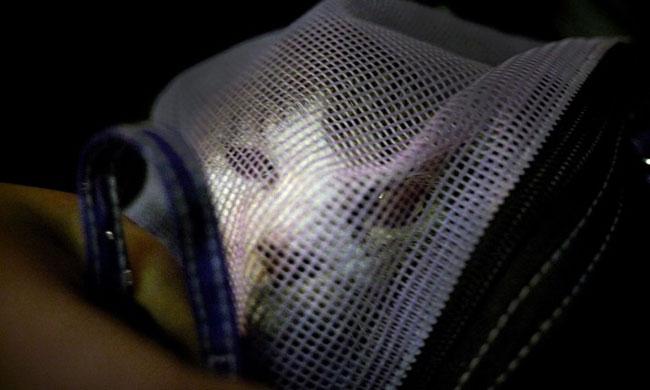
People looking at this photo might possibly see that I’m being cruel. Which is not what I want them to see. I wasn’t trying to hurt her. She looks very scared and sad there. She looks alone. And I don’t like that because she’s not. I wasn’t trying to hurt her. I wanted her to meet my mom.
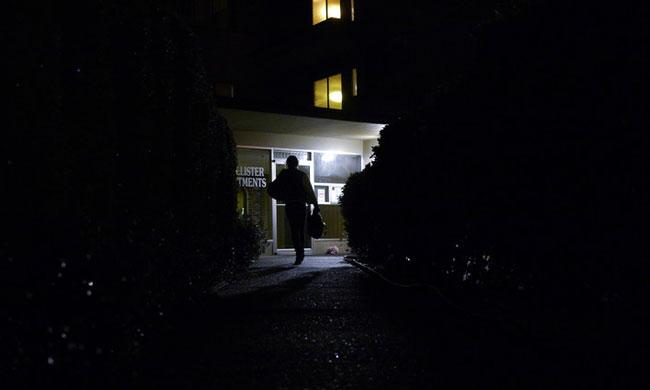
People seeing this photo could think anything . They could think that I’m going to see a drug dealer, they could think basically whatever they want, but that’s not what it is. I was going to see my mom. [I wish viewers could see] my face, the smile on my face that I’m happy to see her. The excitement that I had because it was the first time I had seen her in a while.
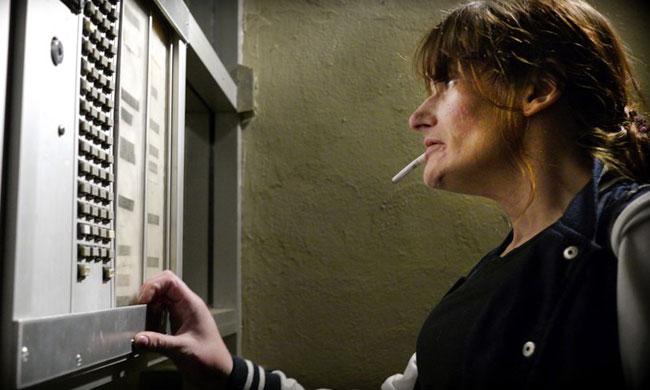
I look confused, maybe a little freaked out or something. I don’t like [the photo]. I wish it weren’t so close up. Maybe it’s a harsh truth, I don’t know.
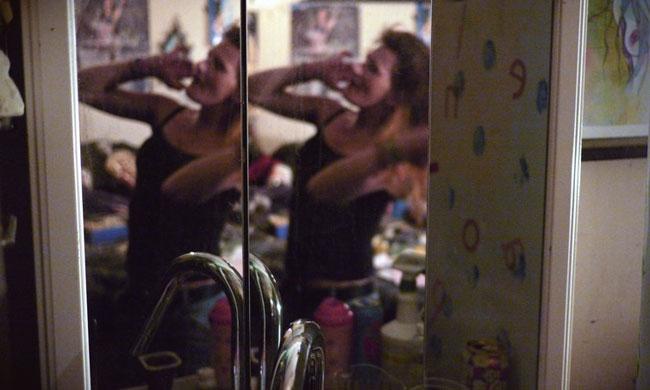
People seeing this photo might see somebody who’s happy, somebody who isn’t so dark or depressed … somebody who’s carefree and playful, and likes to enjoy herself. I do that all the time. I’m always like that … With a smile on my face, I try to always be happy. Which is really hard sometimes, but yeah … It’s me.
Johnny
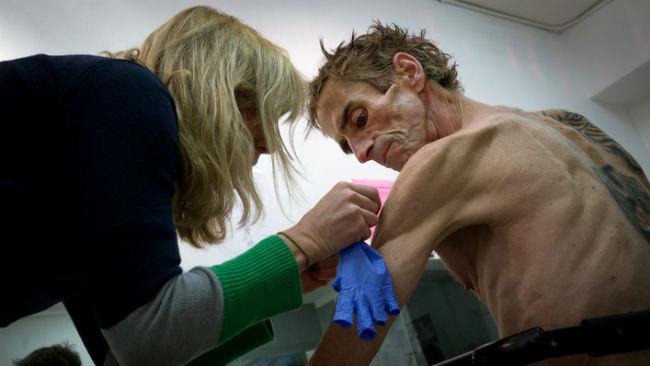
I would like it if maybe they’d let me comb my hair, instead of looking like a real hardcore junkie here. I didn’t realize my hair looked so bad when I take my shirt off.
The reason why I take my shirt off is because I muscle the dope, I don’t IV it, because the reason why I do the dope is different from why a lot of other people do it. They do it to get high, I do it to help with some pain issues I have. I don’t want people thinking, “You know, these guys are going in there taking our tax dollars and doing heroin and getting high, look at them. You know, they’re nothing but detriments to society.” Well, I’ll tell ya, it’s saving my life.
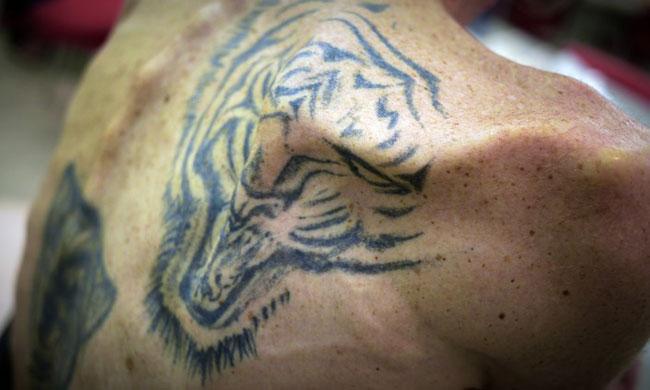
I have a love for animals, especially cats. I had a cat in my life for the last year-and-a-half … well, no, the last eight months. And the more time I spent with humans, the more I love my cat.
I’m not much on being a show off, that’s why I put [the Siberian tiger tattoo] on my back … It’s something I’ve always wanted to do … and I managed to do that.
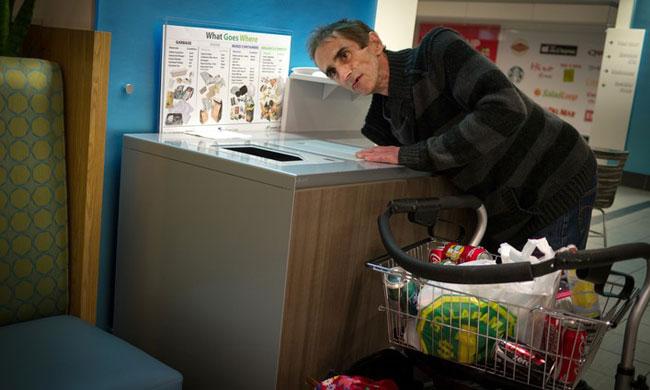
In this photo I’m trying not to break the law and grab some bottles and cash them in. So I can basically eat and have food. What’s missing is the security guards who usually hassle me. And they have no reason to because I’m not hurting or stealing from them.
I’m also helping the environment because 80 percent of these bottles end up going to the landfill or the garbage. It’s not good for our ecosystem.
At this point in my life, I feel like I could come home at night and look in the mirror and not feel guilt or shame for what I was doing out there. Because I’m not stealing from anybody or hurting anybody.
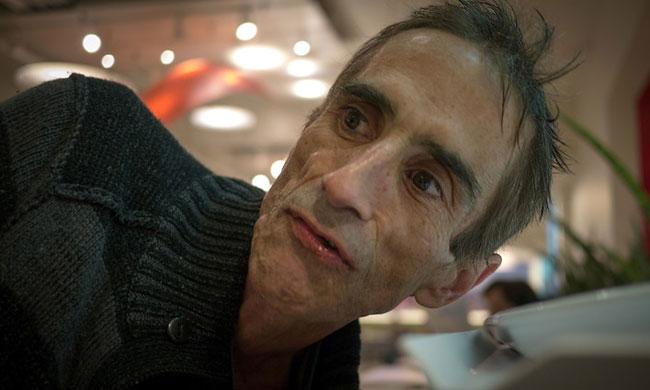
People looking at this photo will see a fella who looks very intense. He looks tired. He’s out trying to make an honest dollar. He’s not proud of what he’s doing. But he’s doing what he has to, in order to survive. At the point where I’m at in my life, I think it’s a 100 percent accurate description of where my life is at. You can see the weariness, the life, the trials and tribulations I’ve been through.
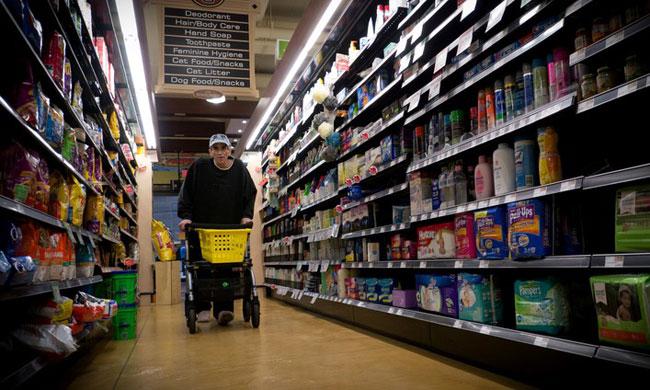
I used to go into the shops and shoplift. I shoplifted quite a bit of food from this shop to feed my drug addictions, and that’s one thing you don’t see in this picture right now. I came and stole from this place and yet, a year later, I’m welcome to come in that store because I made an immense change and do not steal in there now. I come in and buy food like any other individual, and it makes me so proud to be able to do that.
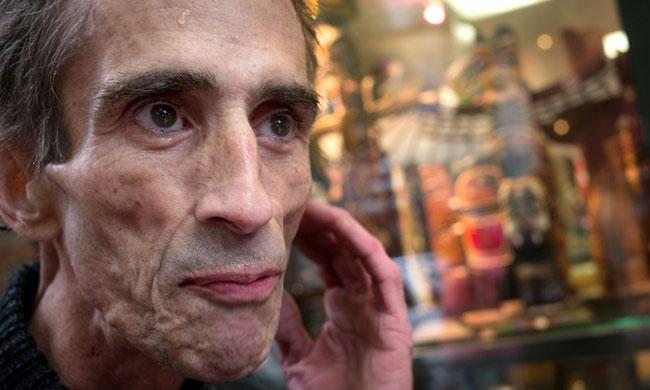
You can see the intenseness in my face. It looks like I’m thinking deep about something and it’s just a feeling of gratitude of being happy and being alive … I hope people get out of this photograph that it’s never too late. And what I’ve been through in my life. We always have a chance as long as we stay positive in the moment. Live in the moment.
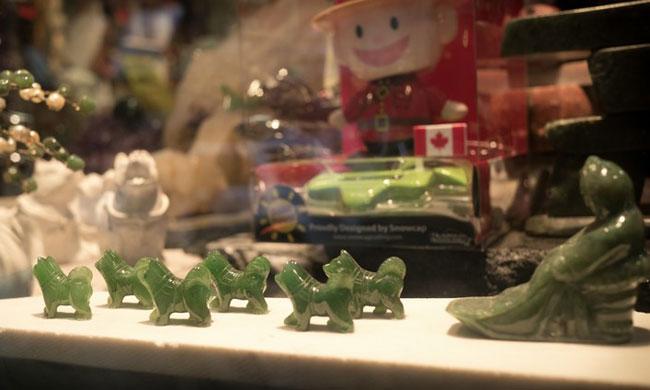
These are some nice carvings. If you look close enough, done in jade. Very nice done little pieces and very expensive little pieces.
This photo represents a point in my life when I needed money to do dope. These were the things I would steal to feed my drug addiction. And they were small enough and easy enough to steal that I would do it. And I had no problem doing it. I never once got caught stealing and grabbing these pieces of ornaments. I would go into the store and take about five minutes. Five minutes of work would keep me unsick for approximately two or three days.
Cheryl
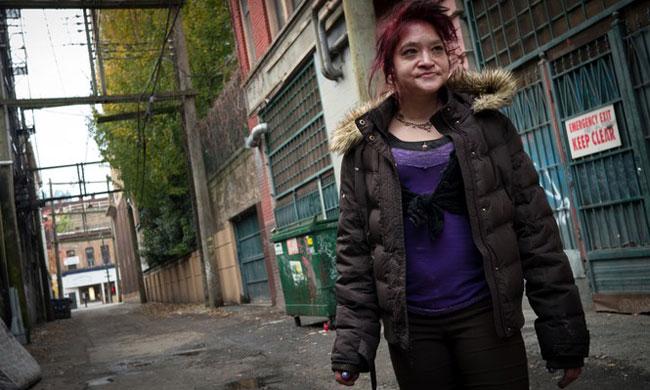
People viewing this photo might see some young girl, downtown, in a back alley. Looks like it’s a rough alley. A young girl, maybe she’s strung out, or maybe she’s determined to find drugs or who knows what they see in this photo. They just see a young girl smiling and looking down the alley.
Yeah, it shows all of me. I just hope the people see me in this photo — that I’m a striving, struggling drug addict. That I’m trying to better my life.
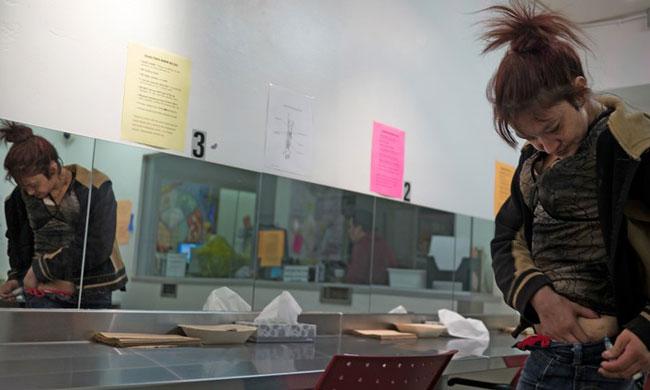
I want to show the people that this place is where we get our injections for our heroin opiate program, just show them that we need these places so heroin addicts can get off the streets. Heroin can be contaminated with many different poisons out there that can severely give us infections, because they put hog dewormer in the heroin on the streets. The clinical heroin here, there’s no bad chemicals or poisons in the drug. It helps us through the day, takes our aches and pains away, everything that heroin used to do.
In other places of the world, they had this study and it’s helped them, that’s why they brought it to Canada, here to [British Columbia]. And for us, the people who are in it, we’re so lucky and should be so grateful to have such a great program.
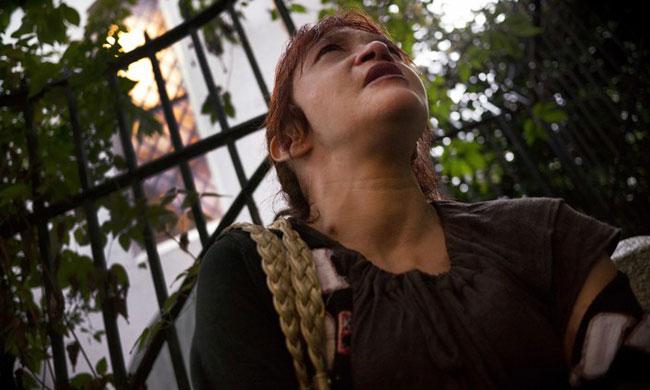
I hope the people see through this documentary all the points, all the emotions and desires, needs, and wants that we need, that you can help us down the road be able to successfully show our governments that people need the extra bit of help because we can’t do it on our own.
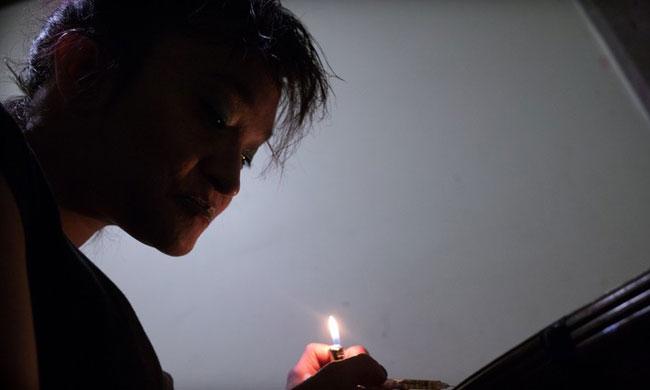
We need for you people to see that we’re not stereotyped monsters. We’re people just like you, just with an addiction. Something that we do a little bit more than others … When you look at this, take it with a grain of salt, because it could be your own daughter, it could be your own son out there doing exactly what I’m doing, but they had the door closed.
A drug addict’s world is not just the drugs, it’s how they get them, what you gotta do to get them. Sex trade, you know. Stealing, killing, whatever it might take just to get that extra dollar to get that extra fix so you can feel numb for the rest of the day. Not necessarily it’s always that, but in my life, I just want you to know that I’m struggling and I need that extra help.
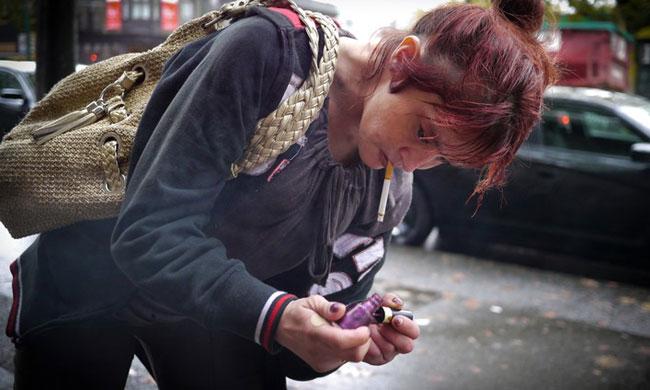
I think the people will see a young girl having a cigarette out in the rain, painting her fingernails, enjoying the weather. Really studying, “Oh, come on, get the last bit of that nail polish out of the bottle.” I am just on the outside in the rain. I’m content. I’m puffing on my cigarette.
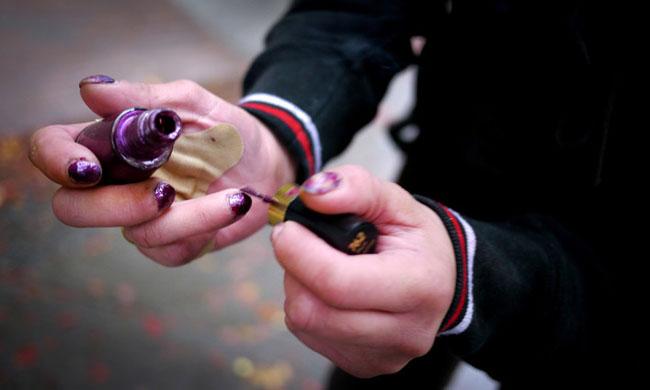
Well, now people will see that I have a band aid on my hand. They might think she has a cut on her hand, that’s why she’s having difficulties painting her fingernails and getting that nail polish out of the jar.
I’m sure there’s hundreds of photos that could show my life different. But my life today is a recovering heroin addict. I’m 124 pounds. I used to weigh 97 pounds. There’s so many good things and positive ways of looking at my life. If a picture could show all that emotion in one? That would be great, but it won’t and that’s all that my voice could tell you.
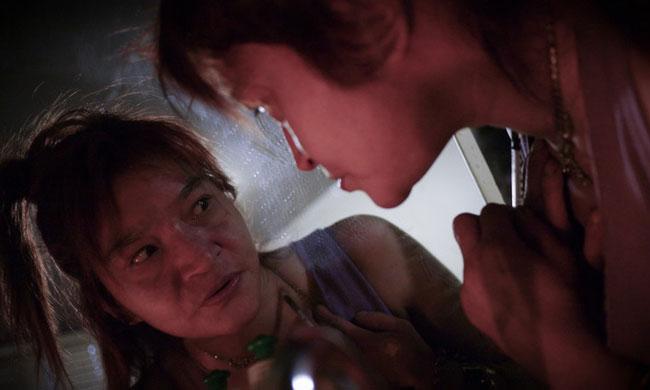
I think that people see a girl looking in the mirror, looking in fear, like what is she doing with the needle in her neck, sticking in her neck, that’s a pretty dangerous site to be injecting. But that’s the reality of that picture. It’s me being all strung out on dope, trying to get that shot into me, and it’s filled with blood and I’m trying to plug it into my vein cause I need that drug that’s in there so I can get off and get high, numb whatever pain I’m going through in that moment.
I was all fucked up on drugs that day, yeah. It shows my emotion, my fear, my determination. [I wish the photo had] maybe a little bit more light … Just to show it’s hard to inject into your neck like that. Just to show the picture more. To see what kind of struggle it is to inject in your neck. And to show maybe just a little bit more emotion to the people just to show what and why I’m doing that to myself.
Postscript: Depicting the lives of users
Throughout the project, I’d spoken with the subjects about the purpose of the photo essay — to challenge the stereotypes of drug genre photography and to help spread awareness about heroin-assisted treatment.
I often explained to them that their photos would likely be published on the internet — that police, future employers and others could learn they are heroin users. Despite the risks, the three subjects reiterated that they wanted to take part in the project because they, too, wanted to tell others about heroin-assisted treatment.
I’d been told that after enrolling in the heroin-assisted treatment study, some participants had reconnected with family members, found stable housing, and gotten jobs. I hoped that I’d be able to take photos of Marie, Cheryl and Johnny in these types of settings.
However, I quickly learned that this wouldn’t be easy. Two of the three subjects didn’t engage in many other activities beyond self-injecting at the Crosstown clinic three times a day. Outside the clinic, much of their time was spent acquiring and using drugs.
This meant the moments I was able to capture ended up being far less varied than I’d anticipated.
Still, there were revealing moments, like when I managed to photograph Marie traveling across the city by bus to try to find her mother. It was Thanksgiving, and she hadn’t seen her mother in more than two years. I thought these particular photos might help the viewer understand Marie in a new way; even if people weren’t able to fully understand the depth of Marie’s suffering or the roots of her addiction, everyone knows what it’s like to want to spend the holidays with loved ones.
The greatest challenge I faced was determining how to document two of the subjects' ongoing drug use outside of the heroin-assisted treatment study. I simply couldn’t ignore it because it was a major part of their day-to-day lives. Marie and Cheryl told me that since the study was double-blind, they might not have been receiving the right medication—or high enough doses—to suppress their need to use other drugs. This doesn’t mean heroin-assisted treatment doesn’t work.
When the time came to choose the final photographs, I deliberately left out images that I suspected could be viewed as the most sensational or degrading.
My photo of Cheryl lit by a candle and injecting drugs into her neck in front of a mirror in her apartment may not appear any less shocking than other drug genre photographers’ images of injection scenes.
However, Cheryl’s own words that accompany the photo provide critical context for the viewer. She explains that she was compelled to buy street drugs and inject into her neck — even though she knew the drugs could be contaminated and possibly kill her — because she was desperate to do whatever she could to feel well, even if this meant risking her life.
In order to see Cheryl as more than a drug user, the viewer needs to know this.
Aaron Goodman is a faculty member in the Journalism and Communication Studies department at Kwantlen Polytechnic University. This article originally appeared in The Conversation.
![]()
